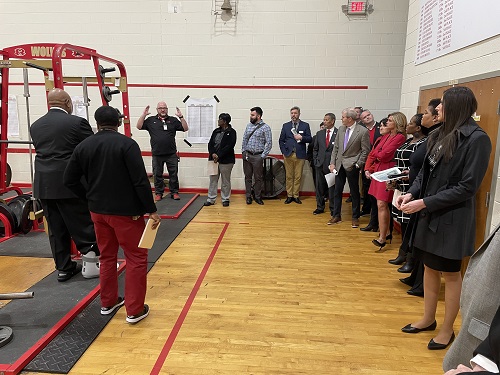Sunday, Jan. 15, 2023–6:46 p.m.
-David Crowder, WRGA News-
The Rome City Commission will hold a called meeting on Tuesday to discuss the Rome Middle School project.

The meeting will begin at 5 p.m. in the Sam King Room at Rome City Hall.
The school system is asking the city commission to back $103 million in bonds for the construction of a new middle school across Veteran’s Memorial Highway from the current facility.
The bonds would be paid back over the next 20 years, using proceeds from education special purpose local sales taxes.
Last week commissioners toured the current middle school facility.
Jason Self with the Rome City School System detailed issues with the current facility. He said there has been only one addition since the middle school opened. The current facility was built for 700 students. There are now over 1,000 and the Rome City school system is expected to average around 140 new students each year.
The department of education requires a certain amount of square footage per facility based on the number of students at that facility. At 2,000 students, the current facility would be short of that requirement for the cafeteria, kitchen, and media center.
Southern A&E Architects prepared two studies that look at using the existing site after commissioners expressed concerns about the price tag for a new facility.
The first study looked at a “demolish and rebuild” scenario that would involve three phases. The first phase would see the addition of a new 135,000-square-foot building on the existing practice field to hold the current student population. It would also have a cafeteria and a new kitchen. This would help keep construction isolated, allowing for classes to operate as normally as possible. The existing gym would be renovated during the summer.
Phase two would involve the complete demolition of the existing school in preparation for phase three, which would include a 108,000-foot addition for classrooms, a new media center, additional administration, and spaces for CTAE (Career, Technical, and Agricultural Education). A 60,000-square-foot gymnasium and fine arts facility would also be constructed on the northwest corner of the site. Athletic fields would need to be located elsewhere.
The estimated cost would be more than $104.7 million for a capacity of 2,000 students and just over $116 million for a capacity of 2,500 — which is close to the $119 million price tag of the proposed facility.
The second study focuses on addition and renovation.
The first phase would be a new 145,000-square-foot, stand-alone building on the east side of the current campus that would house 66 classrooms. A new kitchen and cafeteria would be relocated due to the required expansion of the media center, as part of increasing the full-time enrollment to 2,000 students.
The estimated cost would be just over $72 million to accommodate 2,000 students and close to $80 million for 2,500 students.
Both studies cited potential increased construction costs due to contractors having to be on-site for longer due to the phased approach and possible fluctuations in the cost of construction materials. Other issues include having a disconnected campus, no room for future growth, and no space for additional parking.
According to both studies, using the existing site will not improve, and could potentially make worse, issues with traffic by doubling the number of students and staff.
“I’m very concerned about the safety and the traffic at this building’” said Superintendent Eric Holland. “If you haven’t seen it, try coming through here about 3 o’clock. If we add 6th grade and get up to 2,000 students in a space that cannot hold them, we are going to have some real safety concerns.”
Holland added that if a new facility is not constructed, the school system would lose $9 million in capital outlay funds.
One major concern raised by some on the city commission deals with having money to address growth at other Rome City schools if future ELOST funds are used to pay back the bonds.
Holland said he did not think that would be an issue because there would still be capital outlay funds for the elementary schools and moving 6th grade to the middle school would free up classrooms in the lower grades. The school system has also gotten approval to use federal ESSA funds — from the Every Student Succeeds Act — to add eight classrooms and a 140-seat expansion of the cafeteria at West End Elementary, along with five additional classrooms at East Central Elementary. Moving 6th grade to the new middle school would also free up 4 to 6 additional classrooms at each elementary school.


